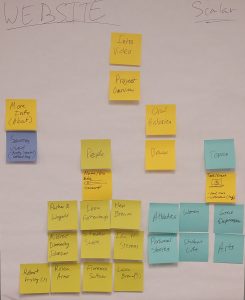I will admit it- at this point, I cannot think of many new ways to define DH. I should be thinking about it proactively and engaging with different communities to better critique my own definition. But this past week has been a whirlwind leading up to our final presentations, and I was unable to devote much time to thinking about the definitions of DH.
My understanding of DH is constantly shifting in small ways. While I retain a general understanding of DH, slight changes occur based on what I am reading and who I encounter. My experiences with DH last summer and this summer differ slightly due in large part to the cohort. I am around different people with different ideas. Our conversations focus on aspects of DH I might not have engaged with before, or frame them in a different way.
This expands to other communities outside of our program. No two DH programs are exactly alike. We had a few opportunities this summer to talk with other digital scholars about their programs. Each had different strengths and focuses. Our program is based around developing the projects of individual students. Other programs focus on applying digital methodology to preexisting work with the help of student specialists. Both are DH, but their implementation varies. If I were to define DH only by what I know now, I would alienate projects and programs I have not yet learned about. DH definitions are constantly expanding.
In short, I have a new definition for every experience I have with DH. The more people I talk to, the more ideas I encounter, and the more broad and refined my own definition becomes. I have a very broad definition of DH because that is what I think is needed. Having a definition that is specific may be easier to understand, but that specificity can be detrimental. It can limit the scope of what we consider DH. Limiting and excluding new and different ideas due to a narrow definition helps no one. Every time I think I have finally figured out DH, I encounter a new project that causes me to reconsider my definition and my place in DH.
Our definition of DH works for our college and the programs we have now. That may not hold true in the future. We should embrace that quality of DH and always be willing to rework our perceptions of DH to accommodate innovation.
While it is important to consider definitions of DH and its place in academia, we should not get tied up in our quest for the perfect definition. One day, that definition will change. That is the beauty of DH.
